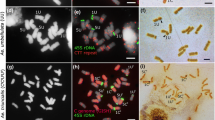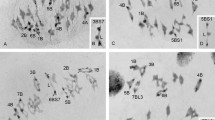Abstract
Two types of intraspecific nucleolar dominance/suppression are described for barley,Hordeum vulgare L. When the nucleolus organizing regions (NORs) originally belonging to chromosomes 6 and 7 are combined by translocation in one chromosome, NOR 6 is dominant over NOR 7. Neither significant loss of rDNA nor its hypermethylation is the reason for the reduced nucleolus forming activity of NOR 7. Intrachromosomal NOR suppression probably does not occur in isochromosome 6s, which has two NORs 6 in one chromosome. Meiotic and somatic pairing of the homologous arms might be the reason for early fusion of their nucleoli and thus for the lower than expected maximum number of interphase nucleoli. Variable suppression of a partial NOR (63) is described for descendants of crosses between translocation lines with split NORs 6 and 7. In these cases also, the reduced activity of the partial NOR 63 is not due to deletion of rDNA as shown by in situ hybridization. Unstable methylation of NOR 63 in heterozygous F1 individuals is probably the cause of this phenomenon.
Similar content being viewed by others
References
Anastassova-Kristeva M, Nicoloff H, Künzel G, Rieger R (1977) Nucleolus formation in structurally reconstructed barley karyotypes with six satellite chromosomes. Chromosoma 62:103–109
Anastassova-Kristeva M, Nicoloff H, Rieger R, Künzel G, Hagberg A (1979a) Nucleolus organizer activity as affected by chromosome repatterning in barley. Barley Genet Newslett 9:9–12
Anastassova-Kristeva M, Rieger R, Künzel G, Nicoloff H, Hagberg A (1979b) Further evidence on ‘nucleolar dominance’ in barley translocation lines. Barley Genet Newslett 10:3–6
Appels R, Gerlach WL, Dennis ES, Swift H, Peacock WJ (1980) Molecular and chromosomal organization of DNA sequences coding for the ribosomal RNAs in cereals. Chromosoma 78:293–311
Cabello P, Gonzales-Fernandez A, Leyton C, Sans J, de la Torre C (1986) Stimulated nucleologenesis in meristematic cells with hypomethylated DNA. Biol Cell 58:91–94
Flavell RB, O'Dell M, Thompson WF (1988) Regulation of cytosine methylation in ribosomal DNA and nucleolus organizer expression in wheat. J Mol Biol 204:523–534
Kenton AY, Owens SJ, Langton D (1988) The origin of ringformation and self-compatibility inGibasis pulchella (Commelinaceae). Kew Chromosome Conference III. HMSO, pp 75–84
Konishi T, Linde-Laursen I (1988) Spontaneous chromosomal rearrangements in cultivated and wild barleys. Theor Appl Genet 75:237–243
Künzel G (1984) Isochromosome for the short arm of barley chromosome 6. Barley Genet Newslett 14:6–8
Lacadena JR, Cermeno MC, Orellana J, Santos JL (1984) Evidence for wheat-rye nucleolar competition (amphiplasty) in triticale by silver staining procedure. Theor Appl Genet 75:207–213
Linde-Laursen I (1984) Nucleolus organizer polymorphism in barley,Hordeum vulgare L. Hereditas 100:33–43
Navashin M (1927) Changes in the number and form of chromosomes as a result of hybridization. Z Zellforsch Mikrosk Anat 6:195–233
Navashin M (1928) ‘Amphiplasty’ — eine neue karyologische Erscheinung. Proc Int Conf Genet 5:1148–1152
Nicoloff H, Anastassova-Kristeva M, Künzel G (1977a) Changes in nucleolar activity due to segmental interchanges between satellite chromosomes in barley. Biol Zentralbl 96:223–227
Nicoloff H, Anastassova-Kristeva M, Künzel G, Rieger R (1977b) The behaviour of nucleolus organizers in structurally changed karyotypes of barley. Chromosoma 62:103–109
Nicoloff H, Anastassova-Kristeva M, Rieger R, Künzel G (1979) ‘Nucleolar dominance’ as observed in barley translocation lines with specifically reconstructed SAT chromosomes. Theor Appl Genet 55:247–251
Ochs RL, Liwsche MA, Shen E, Carrol RE, Busch H (1985) Nucleologenesis: Composition and fate of prenucleolar bodies. Chromosoma 92:330–336
Reeder RH (1985) Mechanisms of nucleolar dominance in animals and plants. J Cell Biol 101:2013–2016
Rieger R, Nicoloff H, Anastassova-Kristeva M (1979) ‘Nucleolar dominance’ in interspecific hybrids and translocation lines — a review. Biol Zentralbl 98:385–398
Schubert I (1990) Both NORs within a tandem duplication inVicia faba L. are active. Biol Zentralbl 109:267–269
Schubert I, Wobus U (1985) In situ hybridization confirms jumping nucleolus organizing regions inAllium. Chromosoma 92:143–148
Yakura K, Tanifuji S (1983) Molecular cloning and restriction analysis of Eco-RI fragments ofVicia faba rDNA. Plant Cell Physiol 24:1327–1330
Author information
Authors and Affiliations
Rights and permissions
About this article
Cite this article
Schubert, I., Künzel, G. Position-dependent NOR activity in barley. Chromosoma 99, 352–359 (1990). https://doi.org/10.1007/BF01731723
Received:
Revised:
Accepted:
Issue Date:
DOI: https://doi.org/10.1007/BF01731723




